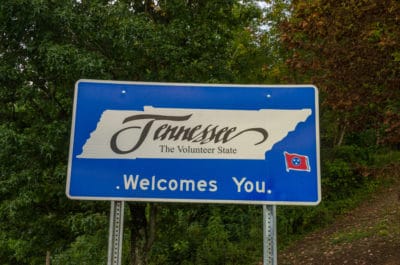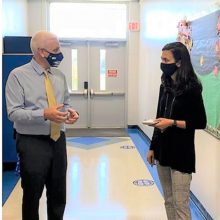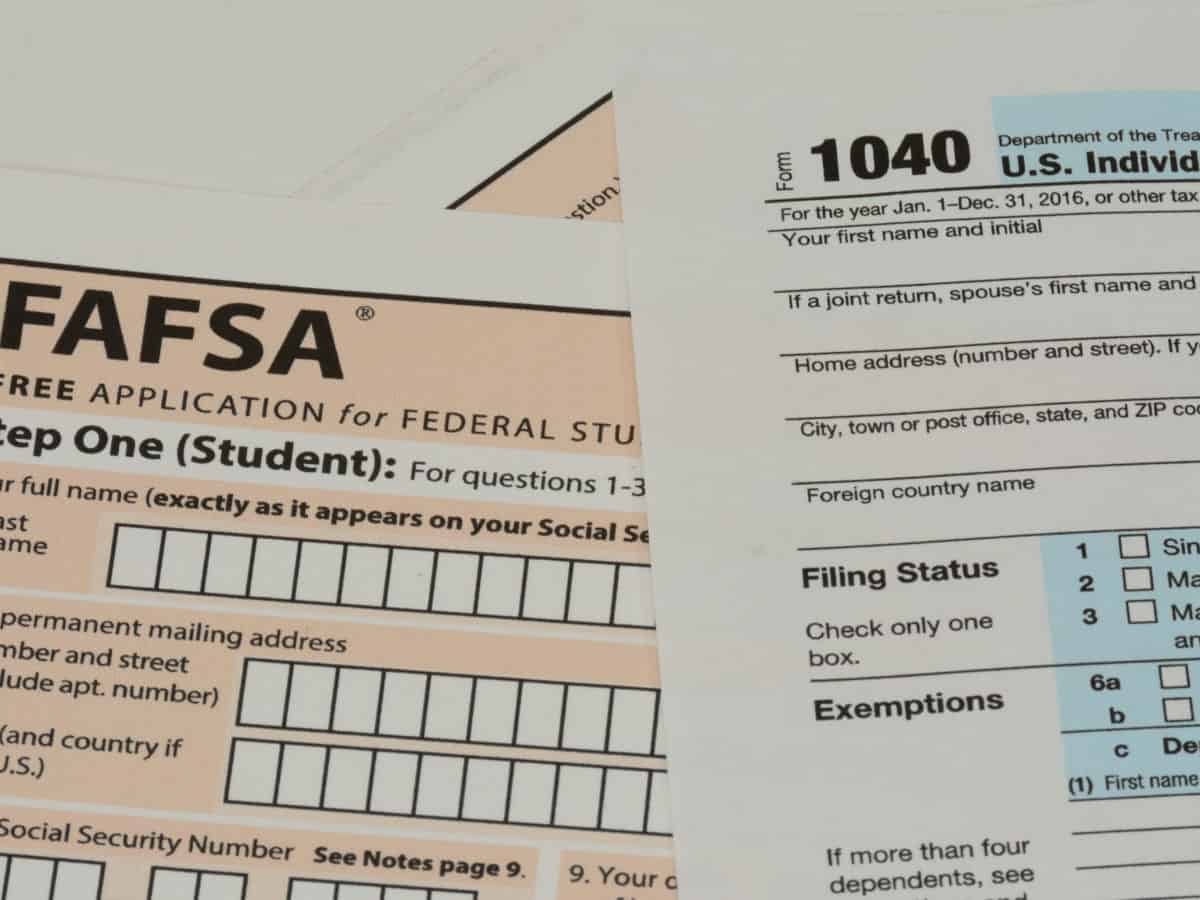
This is the first piece in a series on the FAFSA. Follow along with the rest of the series here.
Last year, North Carolina established the myFutureNC postsecondary attainment goal: by 2030, the state needs 2 million 25- to 44-year-olds to hold a high-quality credential or college degree. On its current trajectory, North Carolina is predicted to have a 400,000 shortfall in individuals with those degrees or credentials in 2030, leaving employers without the skilled workers they need to fill available jobs.
Closing the educational attainment gap means more students need to enroll in postsecondary education, persist in their coursework, and attain a credential or degree. One factor that’s associated with all of those things? Free Application for Federal Student Aid (FAFSA) completion.
According to a 2020 report by Education Strategy Group (ESG), students who complete the FAFSA are more likely to enroll in higher education – 90% of FAFSA completers attend college directly after high school, compared to just 55% of students who don’t complete the FAFSA. And, FAFSA completers are more likely to persist in their coursework and obtain a degree.
The FAFSA is a form used to determine eligibility for federal financial aid, and at times, also determines state, institutional, and private aid. As college tuition costs continue to rise, affordability presents a barrier to attainment for many students. The FAFSA ensures that a postsecondary credential or degree remains in reach.
However, according to the ESG report, less than two-thirds of graduates complete the FAFSA each year, leaving an estimated $3.4 billion in aid on the table annually. Additionally, students of color are less likely to complete the FAFSA – 74% of African-American students and 66% of Hispanic students complete it, compared to 82% of white students.
As of May 15, 2020, North Carolina’s FAFSA completion rate for 2020-21 completers is 52.3%. That ranks in the middle of the pack nationally at 25th. By 2030, myFutureNC has set a FAFSA completion rate goal of 80% – the same as neighboring Tennessee.
As North Carolina looks to boost its FAFSA completion rate in the years to come, the ESG report highlights key barriers to FAFSA completion and six strategies states can use to boost their rates.
Related reading

Barriers to FAFSA compleition
Lack of awareness
Students and families may not know what the FAFSA is, how to complete it, or why it is important. In a survey of fall 2009 ninth-graders who graduated from high school but did not complete a FAFSA, 23% did not have enough information to complete the FAFSA and 32% thought they or their family may be ineligible or would not qualify for financial aid.
And, unlike the also-complicated college application process, the ESG report says “limited media and marketing about the FAFSA exists, requiring individuals to proactively seek out information about the form.”
Form complexity
The FAFSA includes more than 100 questions that require complex tax data, often making it burdensome to complete. And, once the form is submitted, students may be selected for a verification process where they are asked to submit additional documentation to confirm the information submitted in their FAFSA.
In December 2019, Congress passed the FUTURE Act, a bill that simplifies the FAFSA process by allowing students to provide consent to the IRS to share their taxpayer data with the Department of Education. That means income data will be automatically filled in, eliminating up to 22 of the 108 questions and reducing the need for an additional verification process.
Parental mistrust
During interviews that ESG completed for the report, parental mistrust was one of the most common reasons cited for not completing the form.
“This fear is felt particularly deeply by undocumented families, who may feel that they have to choose between affording college and identifying themselves to the government as undocumented,” states the report.
While undocumented students are not eligible for federal financial aid, completing the FAFSA can still provide them with access to aid from institutions and at times states.
Limited state resources
In the broader landscape of helping students make the transition from high school to postsecondary education, “supporting students in navigating bureaucracy often falls far down the list.”
Policies and programs are often focused on increasing academic performance, while supports for guidance and advising are less emphasized at the state policy level. This leaves schools and districts with limited resources for helping students navigate how to complete the FAFSA.
6 strategies to boost FAFSA completion
Through interviews, state and local leaders and practitioners – including those at school districts, a community college, state education agencies, and nonprofit organizations – ESG determined six high-impact strategies for increasing FAFSA completion: set a goal, build shared ownership, create incentives, use data, establish partnerships, and spread awareness.
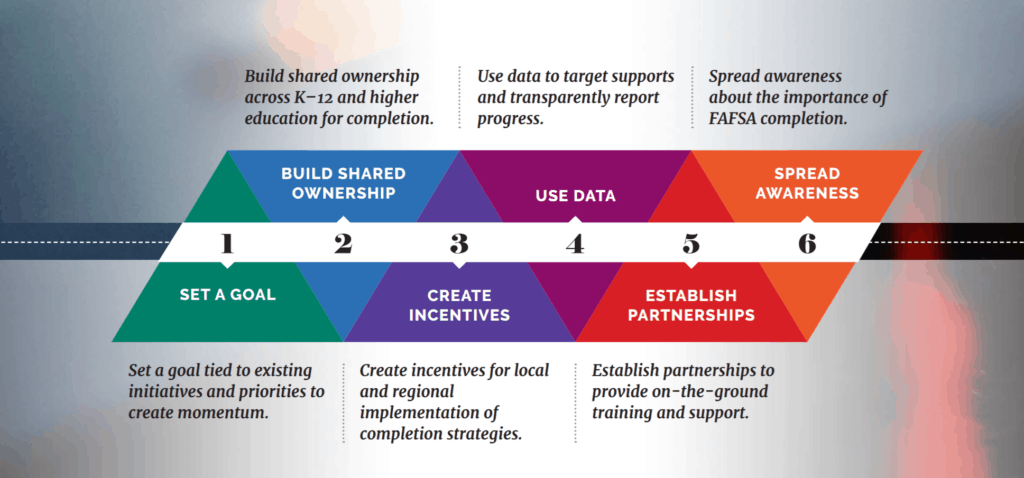
Set a goal
“The state should start by setting an ambitious, yet realistic goal for increasing FAFSA completion. This goal can be statewide, regional, or targeted towards schools and districts.”
A concrete goal can provide a north star to unify efforts across stakeholders – as North Carolina understood with the creation of the myFutureNC postsecondary attainment goal in 2019. Along with that attainment goal, myFutureNC also established a series of other goals, one of which is increasing the state’s FAFSA completion rate to 80% by 2030.
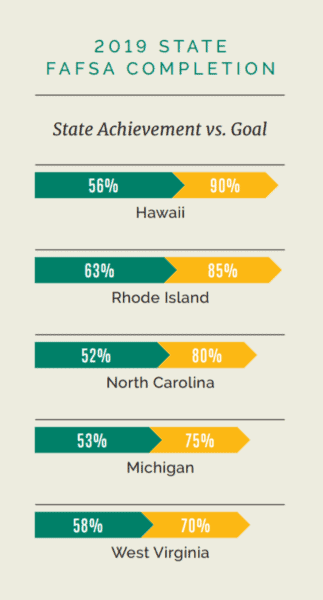
Other approaches to goal-setting highlighted in the ESG report include:
- Rhode Island: Established a goal for the state (85% completion) and a minimum goal for individual schools (70%).
- Colorado: Every year, the state sends high school principals a letter encouraging them to increase their FAFSA completion rate by 5-10% over last year, based on prior examples of improvement from similarly-populated schools.
- Grand Prairie Independent School District in Texas set an overall goal of 65% of eligible high school seniors completing the FAFSA, and established an interim goal for 50% of those seniors to complete the FAFSA before January 15. This concrete target allowed the district to reach a completion rate of 69%.
The ESG report emphasizes the importance of tying the FAFSA completion goal to existing priorities around postsecondary attainment, something myFutureNC is doing.
The report also recommends integrating FAFSA completion into state graduation requirements, something both Texas and Illinois recently did. The requirement increases the incentive for students to complete the FAFSA, but should still permit students and families to opt-out. After passing legislation that requires all students to fill out a FAFSA in order to graduate high school, Louisiana saw completion rates rise dramatically to over 78%.
Build shared ownership
“For an initiative to be successful, it’s essential that the right people are at the table.”
The ESG report recommends that leaders from K-12 and higher education build shared ownership of the FAFSA goal and create opportunities to collaborate on strategies to drive completion forward. The state should create ways for them to engage with other stakeholders and to share out best practices. Ensuring that no one agency, organization, or sector is responsible for the goal allows for sustainability of the initiative, even when leadership changes.
As an example, the ESG report highlights the Tennessee Higher Education Commission, which manages a team with representatives from the Tennessee Department of Education, tnAchieves, the Tennessee Students Assistance Corporation, and the Ayers Foundation to design and implement FAFSA completion plans each year.
Beyond convening a state-level group, the state can also support planning at the local and regional level by holding conferences, developing grant programs, or requiring districts or regions to complete plans for increasing FAFSA completion. Denton Independent School District in Texas created a regional committee of district administrators and representatives from local higher education institutions who created a strategic plan for FAFSA completion and met several times through the year to ensure the plan was implemented.
Create incentives
“With schools and districts often fatigued by initiative overload, the state should offer compelling incentives to prioritize FAFSA completion.”
Completion challenges can spur action at the local level. The ESG report recommends that states launch a statewide FAFSA challenge where schools and districts compete to reach certain targets, perhaps with funding attached. For example, Vancouver Public Schools in Washington created a thermometer graphic for each high school’s career center page that was updated weekly to track progress, spurring competition among schools.
And, by offering funding in the form of competitive grants, states can ensure funding is targeted to underserved populations or to schools and districts that have historically seen low completion rates. Grants may be used to cover costs such as salaries for program coordinators or counselors, staffing and supplies for FAFSA events, or incentives for students. The ESG report also recommends that states stay informed of local practices so that they can “identify, codify, and share examples of successful implementation for other districts to emulate.”
Use data
“Having access to accurate, timely data is essential for states to monitor progress and to prioritize support to schools and districts.”
Accurate and timely data is essential for states to monitor progress and to support schools and districts. The ESG report recommends that high school counselors and administrators have timely access to student-level data on FAFSA completion, enabling them to target outreach and support to those who need it most. For example, the Louisiana Office of Student Financial Assistance manages a statewide data system that cleans, reviews, and reports on student-level FAFSA completion data on a weekly basis.
Additionally, necessary data sharing agreements should be established, platforms should be accessible and user-friendly, and data should be consistent across sources, allowing all relevant stakeholders in K-12 and higher education to leverage it. Data should be used to target necessary supports to schools and students, and when the data is shared publicly, it should include both aggregated and disaggregated data on FAFSA completion.
Establish partnerships
“Providing the support necessary to move the needle on the state’s FAFSA completion goal requires boots on the ground. It is capacity heavy, as each student needs individualized help to get across the finish line.”
Tapping into community organizations and volunteers can help schools expand the number of adults who can support students and families through the FAFSA completion process. The ESG report recommends that states recruit volunteers from colleges, government agencies, and community organizations to provide support directly to students and families.
The Texas Higher Education Coordinating Board established college and career centers within institutions to provide advising services to high school students. Centers were staffed by current college students and partnered with local high schools to host FAFSA events and work individually with students. Nonprofits, such as the National College Access Network, can also provide supports such as staff, resources, direct services, physical space, or even funding.
The report also recommends developing training resources and providing professional development to high school counselors, educators, and administrators.
Spread awareness
“One of the most significant barriers to FAFSA completion is the lack of awareness about its importance.”
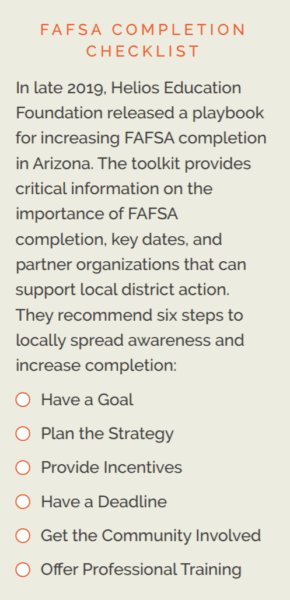
States can play an important role in addressing common misconceptions about the FAFSA. The report recommends that states develop communications resources, tools, and training materials for schools and districts to use in their advising efforts. Puget Sound College & Career Network in Washington developed a financial aid toolkit that included student materials, family letters, lesson plans, and promotional materials.
The report also recommends that states build a marketing campaign centered around increasing FAFSA completion rates, including things like slogans, logos, and talking points for districts and schools to use in communications with students and families. Ohio’s “3 to Get Ready” campaign focuses on applying for financial aid, submitting college applications, and selecting an institution in which to enroll.
Resources should be published on agency websites, shared with schools and districts for their own websites, and sent out via other channels such as social media and newsletters. The information should be consistent, written in easy-to-understand language, and free from errors.
While each recommendation can improve FAFSA completion rates, the ESG report says that states need to build a cohesive strategy with multiple approaches to significantly move the needle. Follow along on EdNC.org the rest of the week as we continue to explore FAFSA completion in North Carolina.
Read the full ESG report below, and pay special attention to the Louisiana profile on page 22 and the Tennessee profile on page 23 to see how two states built a cohesive effort around boosting FAFSA completion rates.
Look up your high school’s FAFSA data
The following data is from the Federal Student Aid office of the Department of Education. Type the name of any North Carolina high school to see the number of FAFSA applications that have been submitted and the number of FAFSA applications that are complete as of May 8, 2020 for the 2020-2021 cycle. For comparison, you will also see what those figures were as of May 8, 2019 for the 2019-2020 cycle.
Note: Please use these tips when searching for a school. In the case that there are multiple schools in the state with the same name, please reference the original data source here.
- Drop the word “school” from the end of the name. (i.e. Knightdale High instead of Knightdale High School).
- Include the word “High” or “Academy” in the school name, if relevant. (i.e. North Edgecombe High instead of just North Edgecombe)
- Include the word “Early College” for early colleges, but not “High.” (i.e. Buncombe County Early College)
- If the school is named after an individual, only include the last name. (i.e. Needham Broughton High is just Broughton High)
Recommended reading


